
The Codex Manesse is a Liederhandschrift, the single most comprehensive source of Middle High German Minnesang poetry, written and illustrated between c. 1304 when the main part was completed, and c. 1340 with the addenda.
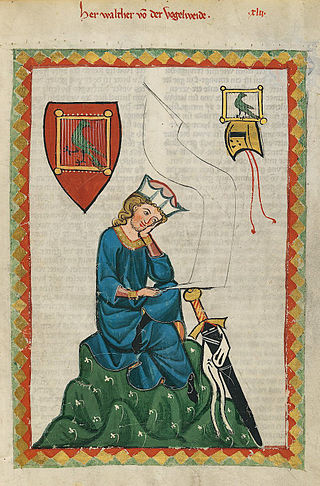
Minnesang was a tradition of lyric- and song-writing in Germany and Austria that flourished in the Middle High German period. This period of medieval German literature began in the 12th century and continued into the 14th. People who wrote and performed Minnesang were known as Minnesänger, and a single song was called a Minnelied.

Walther von der Vogelweide was a Minnesänger who composed and performed love-songs and political songs ("Sprüche") in Middle High German. Walther has been described as the greatest German lyrical poet before Goethe; his hundred or so love-songs are widely regarded as the pinnacle of Minnesang, the medieval German love lyric, and his innovations breathed new life into the tradition of courtly love. He was also the first political poet to write in German, with a considerable body of encomium, satire, invective, and moralising.
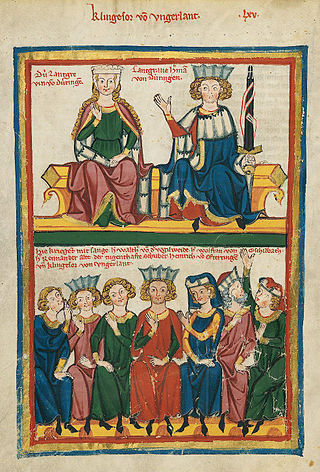
Heinrich von Ofterdingen is a fabled, quasi-fictional Middle High German lyric poet and Minnesinger mentioned in the 13th-century epic of the Sängerkrieg on the Wartburg. The legend was revived by Novalis in his eponymous fragmentary novel written in 1800 and by E. T. A. Hoffmann in his 1818 novella Der Kampf der Sänger.
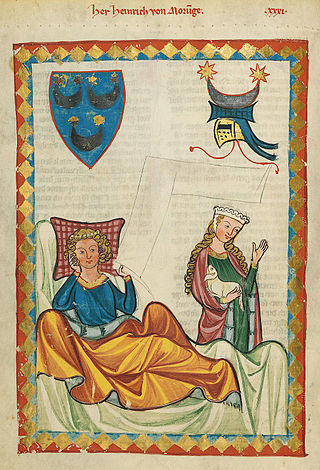
Heinrich von Morungen was a Minnesinger, whose 35 surviving Middle High German songs are dated on both literary and biographical grounds to around the period 1190–1200. Alongside Walter von der Vogelweide and Reinmar he is regarded as one of the most important Minnesänger: he was "the most colourful, passionate, tender and musical of the Minnesänger" and his work "marks a new and brilliantly effective stage in the development of the German lyric."
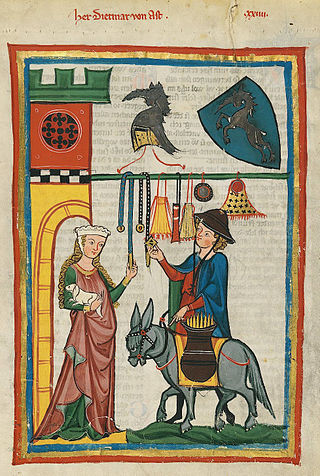
Dietmar von Aist was a Minnesinger from a baronial family in the Duchy of Austria, whose work is representative of the lyric poetry in the Danube region.

The Palästinalied is a crusade song written in the early 13th century by Walther von der Vogelweide, the most celebrated lyric poet of Middle High German literature. It is one of the few songs by Walther for which a melody has survived.
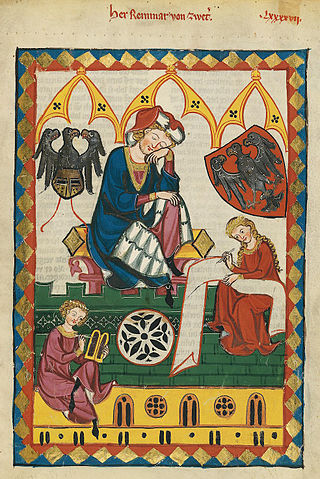
Reinmar von Zweter was a Middle High German poet of Spruchdichtung. The iconography in the Manesse Codex suggests that he may have been blind, since he is the only person represented in the manuscript with closed eyes and other people writing. The caption, not shown here, of that miniature refers to him as "Herr" Reinmar, implying that he was a knight and that he became blind in adulthood.

Reinmar von Hagenau was a German Minnesänger of the late twelfth century who composed and performed love-songs in Middle High German. He was regarded by his contemporaries as the greatest Minnesänger before Walther von der Vogelweide, a view widely shared by modern scholars. Although there are uncertainties as to which songs can be reliably attributed to him, a substantial body of his work — over 60 songs — survives. His presentation of courtly love as the unrequited love of a knight for a lady is "the essence of classical Minesang".

The Sängerkrieg, also known as the Wartburgkrieg, was a contest among minstrels (Minnesänger) at the Wartburg, a castle in Thuringia, Germany, in 1207.

"Under der linden" is a well-known poem written by the medieval German lyric poet Walther von der Vogelweide. It is written in Middle High German. The song may have originally been sung to the surviving melody of an old French song, which matches the meter of the poem.
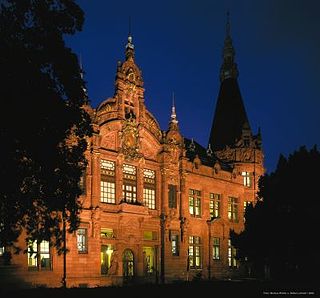
The Heidelberg University Library is the central library of the Heidelberg University. Together with the 83 decentralized libraries of the faculties and institutes, it forms the University Library System, which is headed by the director of the University Library. The University Library holds special collections in literature concerning the Palatinate and Baden, egyptology, archeology, the history of art, and South Asia. It holds about 3.2 million books, 6,000 printed scientific periodicals, and about 500,000 other media such as microfilms and video tapes. The libraries of the faculties and institutes hold another 3 million printed books. In 2022, the University Library registered 43,600 active users who accessed more than 746,000 books. The conventional book supply is complemented by numerous electronic services, including approximately 152,00 electronic journals. The University Library provides around 1,100 reading- and workspaces in the main library in the old town and around 320 reading- and workspaces in the branch in the Neuenheimer Feld, including many IT-workstations and research stations equipped with PCs.

Heinrich von Veldeke is the first writer in the Low Countries known by name who wrote in a European language other than Latin. He was born in Veldeke, which was a hamlet of Spalbeek, part of the municipality of Hasselt, Limburg, Belgium, since 1977. The "Vel(de)kermolen", a water mill on the Demer River, is the only remainder of the hamlet. In Limburg, he is celebrated as a writer of Old Limburgish.
Liederhandschrift, German for Manuscript of the Songs, is the German term for a manuscript containing lieder (songs) of the German Middle Ages, dating from the late 12th to the 15th centuries. Of particular importance are the Minnesang manuscripts of the 13th to 14th centuries.

Spruchdichtung or Sangspruchdichtung is the German term for a genre of Middle High German sung verse. An individual work in this genre is called a Spruch, literally a "saying", and may consist of one or more strophes.
Middle High German literature refers to literature written in German between the middle of the 11th century and the middle of the 14th. In the second half of the 12th century, there was a sudden intensification of activity, leading to a 60-year "golden age" of medieval German literature referred to as the mittelhochdeutsche Blütezeit. This was the period of the blossoming of Minnesang, MHG lyric poetry, initially influenced by the French and Provençal tradition of courtly love song. The same sixty years saw the composition of the most important courtly romances. again drawing on French models such as Chrétien de Troyes, many of them relating Arthurian material. The third literary movement of these years was a new revamping of the heroic tradition, in which the ancient Germanic oral tradition can still be discerned, but tamed and Christianized and adapted for the court.

Reinmar von Brennenberg was a minnesinger and ministerialis to the Bishop of Regensburg in the 13th century.

Meinloh von Sevelingen was a 12th-century Minnesänger from Swabia and one of the earliest poets in the tradition.

The Weingarten Manuscript is a 14th-century illuminated manuscript containing a collection of Minnesang lyrics. It is currently in the Württembergische Landesbibliothek, Stuttgart, with the shelf-mark HB XIII 1. In Minnesang scholarship it is referred to as Manuscript B.

Walther von Mezze was German lyric poet in the Minnesang tradition, probably active in the first half of the 13th century.















